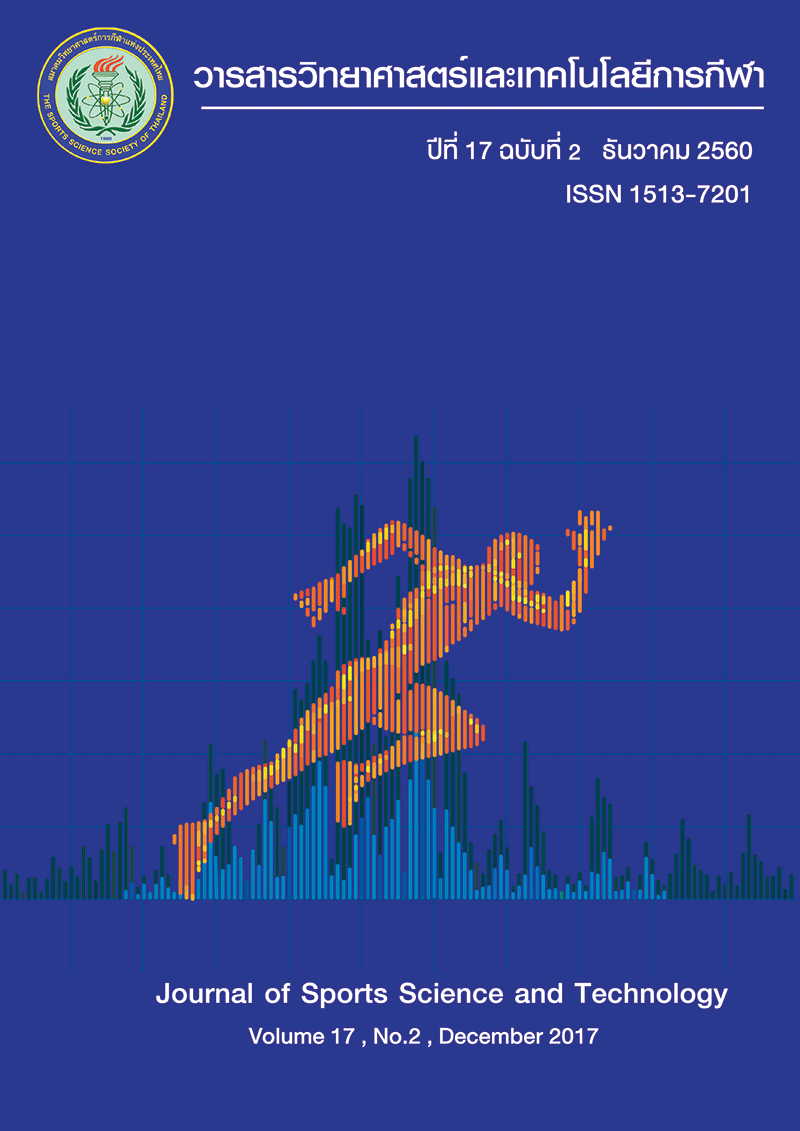THE LANDING ERROR SCORING SYSTEM BETWEEN RECREATIONAL AND COLLEGIATE FEMALE ATHLETES
Keywords:
Landing Error Scoring System / Skill Level / Female Athletes / ACL InjuryAbstract
Knee is one of the most body parts which can be injured from sport activities, especially in female. Low skill athletes had higher injury rate when compared to more skilled athletes. Thus, the Landing Error Scoring System (LESS) has been reported as a valid and reliable clinical assessment tool. LESS was used to evaluate risks for anterior cruciate ligament (ACL) injury by assess quality of jump-landing technique. The objective of this study was to find the relationship of LESS score between two groups of different skill level female athletes. Forty-four participants were recruited from female undergraduates of Mahidol University. Participants were divided into two groups due to their skill levels. Group I, thirty participants (age; 19.37 ± 1.07 yrs, height; 163.40 ± 6.38 cm, weight; 55.97 ± 8.37 kg, body mass index (BMI); 20.90 ± 2.27) and Group II, fourteen participants (age; 19.29 ± 0.91 yrs, height; 163.82 ± 4.82 cm, weight; 58.22 ± 8.99 kg, BMI; 21.66 ± 2.81). LESS videos were recorded by two cameras at 300 fps at frontal and sagittal plane. Pearson x2 test was used to find and independent between LESS score and skill levels. The significant level was set at p < 0.05
There was no independence between LESS score and skill levels (x2 = 8.899, df = 3, p = 0.031). Recreational level (group I) has higher LESS score than collegiate level (group II). The higher skilled athletes have less errors in landing due to their technique and experience in jump-landing which result in lower LESS score. In conclusion, risk for ACL injury was higher in low skill athletes.
(Journal of Sports Science and Technology 2017; 17(2): 9-18)
Keywords: Landing Error Scoring System / Skill Level / Female Athletes / ACL Injury
*Corresponding author: Kornkit CHAIJENKIJ
College of Sports Science and Technology
Mahidol University, Nakhon Pathom, Thailand 73170
E-mail: kornortho@gmail.com
References
2. Eirale C, Ekstrand Q, Ekstrand J. Epidemiology of injuries in football. ASPETAR, 2012; 144-9.
3. Ekstrand J, Hägglund M, Waldén M. Injury incidence and injury patterns in professional football – the UEFA injury study. BJSM, 2009.
4. Koren ES, Myklebust G, Engebretsen L. Injuries in men’s elite handball - A review of the literature. Faculty of Medicine, University of OSLO, 2010.
5. Olsen OE, Myklebust G, Engebretsen L, Bahr R. Injury pattern in youth team handball: a comparison of two prospective registration methods. Scand J Med Sci Sports, 2006; 16: 426-32.
6. Benjamin G. Serpell, Jennie M. Scarvell, Nick B. Ball, Paul N. Smith. Mechanisms and risk factors for noncontact acl injury in age mature athletes who engage in field or court sports: A summary of the literature since 1980. JSCR, 2012; 26(11): 3160-76.
7. Swärd P, Kostogiannis I, Roos H. Risk factors for a contralateral anterior cruciate ligament injury. KSSTA, 2010; 18: 277-91.
8. Agel J, Arendt EA, Bershadsky B. Anterior cruciate ligament injury in national collegiate athletic association basketball and soccer: a 13-year review. Am J Sports Med, 2005; 33(4): 524-30.
9. Murphy DF, Connolly DAJ, Beynnon BD. Risk factors for lower extremity injury: a review of the literature. BJSM, 2003; 37: 13-29.
10. Padua DA, Marshall SW, Boling MC, Thigpen CA, Garrett WE Jr., Beutler AI. The landing error Scoring system (LESS) is a valid and reliable clinical assessment tool of jump-landing biomechanics: The JUMP-ACL study. Am J Sports Med, 2009; 37(10): 1996-2002.
11. Peterson L, Junge A, Chomiak J, Graf-Baumann T, Dvorak J. Incidence of football injuries and complaints in different age groups and skill-level group. Am J Sports Med, 2000; 28(5): S51-7.
12. Chomiak J, Junke A, Peterson L, Dvorak J. Severe injuries in football players. Influencing factors. Am J Sports Med, 2000; 28(5): S58-68.
13. Koch M, Zellner J, Berner A, Grechenig S, Krutsch V, Nerlich M, Angele P, Krutsch W. Influence of preparation and football skill level on injury incidence during an amateur football tournament. Arch Orthop Trauma Surg, 2016; 136(3): 353-60.
14. Padua DA, Boling MC, Di Stefano LJ, Onate JA, Beutler AI, Marshall SW. Reliability of the landing error scoring system-real time, a clinical assessment tool of jump-landing biomechanics. J Sports Rehabil, 2011; 20(2): 145-56.
15. Padua DA, Di Stefano LJ, Beutler AI, de la Motte SJ, Di Stefano MJ, Marshall SW. The landing error scoring system as a screening tool for an anterior cruciate ligament injury – prevention program in elite-youth soccer athletes. J Athl Train, 2015; 50(6): 589-95.
16. Theiss JL, Gerber JP, Cameron KL, Beutler AI, Marshall SW, Di Stefano LJ, Padua DA, De La Motte SJ, Miller JM, Yunker CA. Jump-landing differences between varsity, club, and intramural athletes: The jump-ACL study. JSCR, 2014; 28(4): 1164-71.
17. Hass CJ, Schick EA, Tillman MD, Chow JW, Brunt D, Cauraugh JH. Knee biomechanics during landing: comparison of pre- and postpubescent females. Med Sci Sports Exerc, 2005, 37(1): 100-7.






